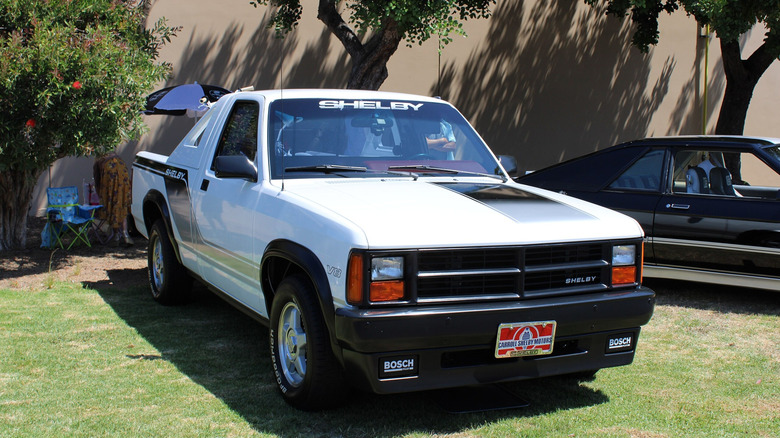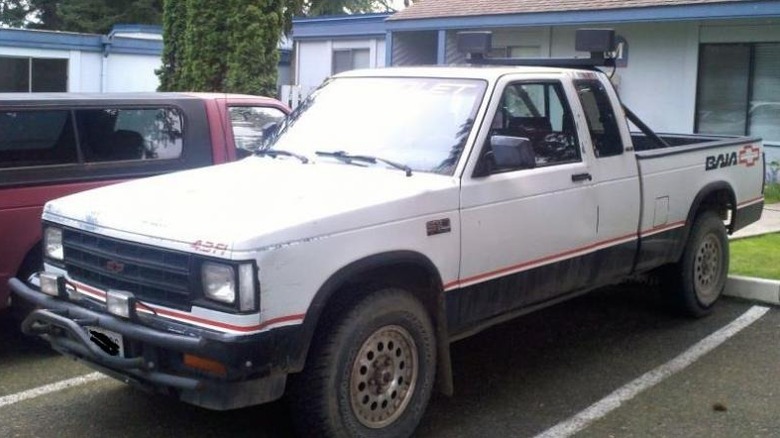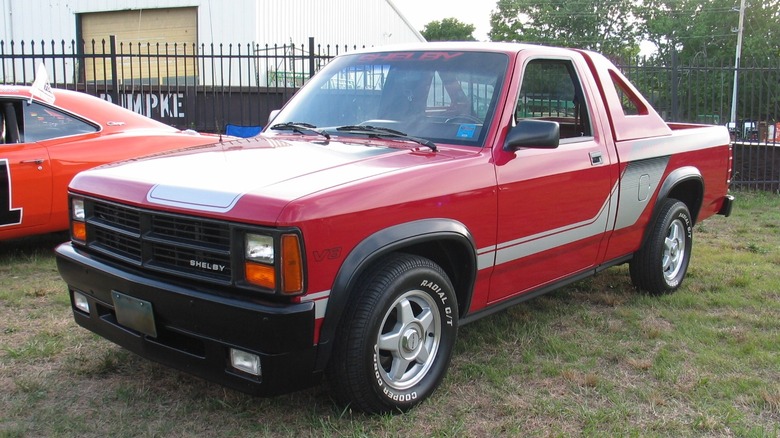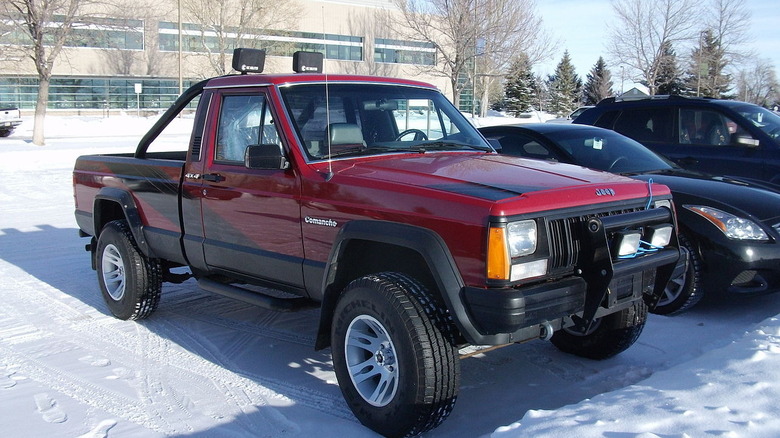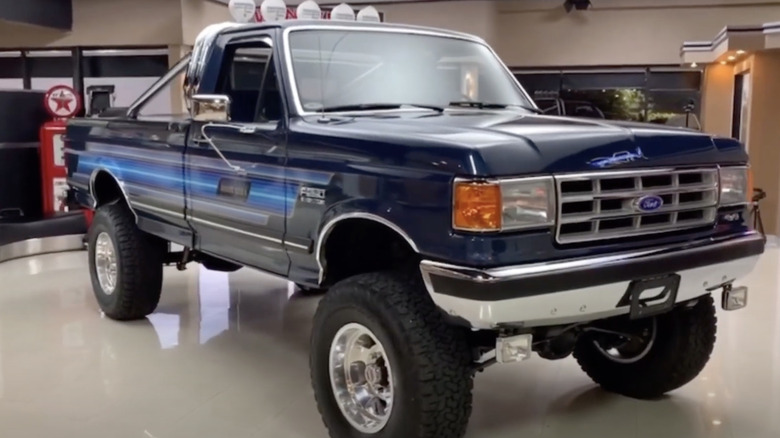5 Of The Highest Horsepower Pickup Trucks Of The 1980s
Modern pickup truck enthusiasts may find it hard to believe that the raw power packed into today's trucks was unimaginable for drivers of earlier generations. With more cutting-edge engineering and persistent innovation, today's pickups are built to dominate the roads by effortlessly delivering jaw-dropping horsepower. Not only that, such machines are expected to haul and tow heavy loads while conquering any terrain.
Among the formidable behemoths of today's pickup market, the 2025 Ram 1500 stands out with its three engine options: a 305-horsepower base V6 and two turbocharged inline-six options that churn out 420 and 540 horsepower. On the EV side of things, the Ford F-150 Lightning flexes its strength with up to an impressive 580 horsepower, while Chevrolet's Silverado EV takes things up a notch with an astonishing 754 horses. And if that's not enough, Rivian's R1T redefines the game with a mind-blowing 1,025-horsepower quad-motor setup, making it one of the most powerful pickup trucks ever built.
These figures are a stark contrast to the underpowered pickups of decades past, where reaching the 120-horsepower mark was considered an accomplishment. The evolution of these workhorses has been nothing short of extraordinary, especially for pickup fans. To see just how far the development of pickup truck engines has come, we have compiled this list of some of the highest-horsepower pickup trucks of the 1980s.
1988 Chevrolet S-10 Baja - 160 horsepower
Not long after the S-10's release in 1982, General Motors introduced the Baja package with more rugged styling and some off-road ready goodies. The package — formally released in 1989 — transformed the S-10 into a versatile 4x4 with its 4.3-liter V6 engine that produced 160 horses. With ample horsepower, the S-10 Baja was a good choice for off-road adventures and hauling. The five-speed manual transmission further enhanced its appeal to drivers who valued control and responsiveness.
Visually, the S-10 Baja exuded a bold presence that set it apart from standard compact trucks of this period. The Baja package included skid plates, a roll bar, a tubular bumper, and off-road lights. It also came with large bowtie and Baja graphics, a windshield decal, and lower-body striping as seen in the photo above. An upgraded suspension system ensured the truck could handle rough terrain with ease. Though the Baja package itself was largely cosmetic, it solidified the S-10's status as a desirable off-road truck.
Chevrolet continued to refine the S-10 through incremental improvements, including the addition of anti-lock brakes and an electronic instrument cluster by the end of the decade. While the S-10 Baja remains a standout model from the 1980s, the broader S-10 lineup maintained its popularity well into the following decade. The Baja package hung around through 1991, and the second-gen S-10 launched in 1994 with the same body-on-frame architecture that made the first generation so durable.
1989 Dodge Shelby Dakota - 175 horsepower
Renowned automotive designer Carroll Shelby didn't just come up with the designs for the iconic Shelby Cobra, Ford GT40, and other vintage sports cars. He was also the brilliant mind behind the Dodge Shelby Dakota, which made it to our list of the coolest Trucks From The '80s. Though it was only available for one year and in limited numbers, the Shelby Dakota turned the small pickup into a performance vehicle.
The original Dakota pickup truck came out in 1986, offering a decent 125 horsepower. The Shelby-designed rear-wheel-drive model, which hit showrooms three years later, boasted a 5.2-liter V8 engine capable of 175 horsepower, which was impressive by 1980s standards. It was mated to a four-speed automatic transmission and the Shelby Dakota was only available with rear-wheel drive.
The 1989 Dodge Shelby Dakota also launched with cosmetic upgrades. Inside, its red bench seat featured charcoal inserts, while the steering wheel was wrapped in leather. Ensuring distinction from the older Dakota, this model launched with a personalized nameplate bearing each truck's production number. On the outside, the blacked-out bumpers, grille, and fender flares further distinguished the Shelby-designed pickup.
1988 Jeep Comanche Eliminator - 177 horsepower
The Jeep Comanche — first introduced in 1986 — was a standout in the compact pickup segment in the '80s. The standard Comanche debuted with modest engine options, including a 117-horsepower four-cylinder and a 115-horsepower GM-built 2.8-liter V6. However, the Eliminator variant — launched in 1988 — took things up a notch. It featured a performance-oriented package built around Jeep's 4.0-liter straight-six engine with a 174 horsepower capacity. This was a significant boost compared to competitors like the Toyota SR5 Long Bed and Volkswagen Pickup, which churned out only 95 and 48 horses, respectively.
Jeep continued to refine the Eliminator's performance capabilities, and soon after its introduction, the 4.0-liter straight-six was bumped up to 177 horsepower. At a time when most compact pickups prioritized fuel economy over performance, the Eliminator brought something new to the table. Due to its notable raw output, the Jeep Comanche Eliminator became one of the earliest examples of a high-performance compact pickup. It was also coupled with a five-speed manual gearbox for a more engaging driving experience.
The Eliminator's engine contributed to its impressive towing and off-road capabilities. With 177 horses under the hood, the vehicle had the muscle to tow up to 5,000 pounds — another impressive feat for a compact pickup. Its robust powertrain also allowed it to handle rugged terrain with ease, making it a versatile option for those who wanted a truck that could do more than just haul cargo.
1987 Ford F150 XLT Lariat - 185 horsepower
The Ford F-Series has been the American automaker's flagship entry in the pickup truck market for more than 75 years. If you want a rundown of the model, here's a nifty article about Every Ford F-Series generation ranked worst to best. A notable development came in 1987, when Ford decided to roll out its new electric fuel injection (EFI) systems.
That big change was felt deeply among the F-series offerings. The F-150, which was available in RWD and 4WD configurations, had a fuel-injected six-cylinder engine capable of producing 145 horses. Another F-150 variant with a fuel-injected 5.8-liter engine generated 210 horsepower. Meanwhile, the XLT Lariat trim (pictured above) came with an EFI 5.0-liter V8 that cranked out 185 horsepower.
On top of the new engine options, the 1987 Ford F-Series introduced a bevy of trendy features and bold styling choices for Ford's famous pickup. For instance, flush-mounted headlamps replaced the recessed designs of previous generations. The trucks were also equipped with power steering, power brakes, and ABS brakes as standard. One could say that the 1987 Ford F-Series paved the way for a new era of modern pickups.
1987 Ford F-250 Bigfoot Cruiser - up to 365 hp
Considering that the 1980s was a decade of somewhat underpowered pickup trucks, Ford was up to something when it introduced the 1987 Bigfoot Cruiser. This bold attempt to bring the monster truck phenomenon to every day drivers was based on the F-Series and Ranger. The special-edition package included a three-inch lift, 33-inch tires, heavy-duty shocks, an aftermarket front bumper with a winch, and a distinctive double-hoop roll bar with off-road lighting. It also featured eye-catching graphics and decals inspired by the original monster truck by Bob Chandler, which began life as a 1974 F-250.
Ford only produced around 300 units of this package, making it a rare sight even when it was still new. The F-150 XLT Lariat trim with the Bigfoot Cruiser package came with a 302 cubic inch V8 engine that produced 185 horses. The F-250 Bigfoot Cruiser had a 460-inch big block engine which could produce as much as 365 horsepower.
Even the highly distinctive and rugged appeal of the Bigfoot Cruiser couldn't save it from a troubled production run filled with safety concerns. The Bigfoot Cruiser was rife with issues, including oversized wheels that rubbed against the fenders and brake lines and the tendency of the lug nuts to loosen under pressure. Its cruise control was also at risk of sparking electrical fires.
Ford addressed all of the issues with a recall, which involved a remedy program that basically stripped the cars of their distinctive Bigfoot features. By 1990, the automaker quietly resigned the package. To be fair, the F Series did not need a Bigfoot-branded boost at the time.
